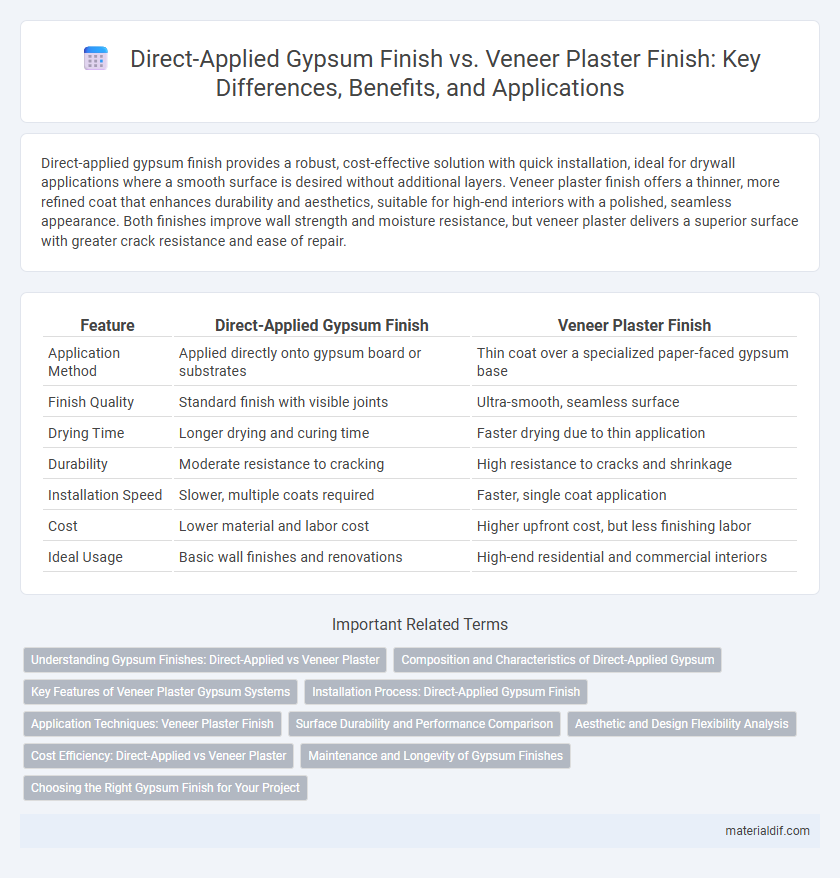Direct-applied gypsum finish provides a robust, cost-effective solution with quick installation, ideal for drywall applications where a smooth surface is desired without additional layers. Veneer plaster finish offers a thinner, more refined coat that enhances durability and aesthetics, suitable for high-end interiors with a polished, seamless appearance. Both finishes improve wall strength and moisture resistance, but veneer plaster delivers a superior surface with greater crack resistance and ease of repair.
Table of Comparison
| Feature | Direct-Applied Gypsum Finish | Veneer Plaster Finish |
|---|---|---|
| Application Method | Applied directly onto gypsum board or substrates | Thin coat over a specialized paper-faced gypsum base |
| Finish Quality | Standard finish with visible joints | Ultra-smooth, seamless surface |
| Drying Time | Longer drying and curing time | Faster drying due to thin application |
| Durability | Moderate resistance to cracking | High resistance to cracks and shrinkage |
| Installation Speed | Slower, multiple coats required | Faster, single coat application |
| Cost | Lower material and labor cost | Higher upfront cost, but less finishing labor |
| Ideal Usage | Basic wall finishes and renovations | High-end residential and commercial interiors |
Understanding Gypsum Finishes: Direct-Applied vs Veneer Plaster
Direct-applied gypsum finish involves the application of gypsum plaster directly onto the substrate, providing a durable and cost-effective surface ideal for standard walls and ceilings. Veneer plaster finish uses a thin coat of plaster applied over a special gypsum baseboard, resulting in a smooth, high-quality surface with superior durability and moisture resistance. The choice between these finishes depends on project specifications, desired texture, and performance requirements in various interior environments.
Composition and Characteristics of Direct-Applied Gypsum
Direct-applied gypsum finish consists primarily of gypsum plaster mixed with additives to enhance adhesion and durability, enabling it to be applied directly onto substrates such as drywall or masonry. This finish is characterized by its fast-setting properties, ease of application, and excellent bonding strength, eliminating the need for additional base coats used in veneer plaster systems. Its composition ensures a smooth, hard surface that provides effective fire resistance and sound insulation, making it ideal for quick renovations and new constructions requiring efficient finishing.
Key Features of Veneer Plaster Gypsum Systems
Veneer plaster gypsum systems offer a smooth, hard, and durable finish achieved through a thin layer of gypsum plaster applied over a specially formulated gypsum board. This finish enhances crack resistance and provides superior fire resistance compared to direct-applied gypsum finishes. The system supports faster installation with fewer finish coats and superior paint adhesion, making it ideal for commercial and high-end residential applications.
Installation Process: Direct-Applied Gypsum Finish
Direct-applied gypsum finish involves applying a gypsum base coat directly onto the substrate, eliminating the need for additional layers or mesh reinforcement. This method simplifies the installation process by reducing labor time and materials, allowing for quicker project completion compared to traditional veneer plaster finish. Skilled application ensures a smooth, durable surface with fewer drying stages, enhancing overall efficiency on-site.
Application Techniques: Veneer Plaster Finish
Veneer plaster finish involves applying a thin coat of plaster over a specially prepared gypsum board with a smooth surface to create a durable, uniform finish. The application technique requires skilled troweling to achieve a seamless, high-quality appearance, often using setting-type joint compounds for faster drying and sanding. This method results in a harder, more impact-resistant surface compared to traditional direct-applied gypsum finishes.
Surface Durability and Performance Comparison
Direct-applied gypsum finish offers enhanced surface durability due to its thicker application, which provides better resistance to impacts and abrasion compared to veneer plaster finish. Veneer plaster finish, while offering a smoother and more refined appearance, tends to be less durable under high-traffic conditions and may require more frequent touch-ups or repairs. Performance-wise, direct-applied gypsum excels in structural integrity and longevity, whereas veneer plaster is preferred for its aesthetic quality and ease of application on prepared substrates.
Aesthetic and Design Flexibility Analysis
Direct-applied gypsum finishes offer a textured, rustic appearance that enhances architectural character but limits surface smoothness and uniformity. Veneer plaster finishes provide a sleek, smooth surface ideal for high-end, modern designs, allowing intricate detailing and seamless joints for superior aesthetic appeal. The choice between these finishes directly influences design flexibility, with veneer plaster supporting more refined and versatile visual outcomes.
Cost Efficiency: Direct-Applied vs Veneer Plaster
Direct-applied gypsum finish offers superior cost efficiency by reducing labor and material expenses compared to veneer plaster finish, which requires multiple layers and skilled labor for proper application. The direct application method minimizes drying time and eliminates the need for additional coats, lowering project timelines and associated costs. Veneer plaster finish, while providing a smoother surface, involves higher upfront investment due to prolonged installation and increased labor intensity.
Maintenance and Longevity of Gypsum Finishes
Direct-applied gypsum finishes typically offer easier maintenance due to their thicker application and durable surface, reducing the need for frequent repairs. Veneer plaster finishes, while providing a smoother, more refined appearance, require careful upkeep to avoid surface cracking and chipping over time. Both finishes benefit from proper installation and conditioning, but direct-applied gypsum generally exhibits greater longevity in high-traffic or moisture-prone areas.
Choosing the Right Gypsum Finish for Your Project
Direct-applied gypsum finish offers a cost-effective and quick installation ideal for projects requiring durability and straightforward application, while veneer plaster finish provides a smooth, high-quality surface with enhanced flexibility and refined aesthetics. Selecting the right gypsum finish depends on factors such as budget, project timeline, desired surface texture, and long-term maintenance requirements. Understanding the performance characteristics and finish quality of direct-applied versus veneer plaster ensures optimal results tailored to specific architectural and design needs.
Direct-applied gypsum finish vs Veneer plaster finish Infographic

 materialdif.com
materialdif.com